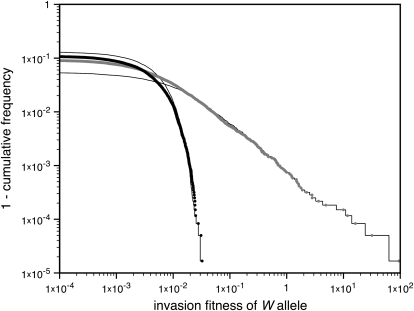Figure 3.—
Heterogamety transitions are governed by a small subset of the sex-antagonistic genes. The invasion fitness of the W allele was calculated for 300,000 random genetic systems, each with 200 sex-antagonistic loci. In each simulation the sex-antagonistic loci were distributed over two linkage groups; two-thirds of the loci were randomly positioned on the ancestral sex chromosomes and the remaining one-third of the loci were randomly positioned on an autosome pair with the novel sex-determination gene. The size of both linkage groups was 100 cM. Despite the twofold bias favoring the ancestral sex-determination system and the large number of loci, we observed positive values of the invasion fitness in ∼10% of the cases. The right tail of the observed distribution of fitness values is shown, with dots indicating invasion fitness estimates from individual simulations (shaded dots, loose-linkage approximation; solid dots, tight-linkage approximation). In both cases, the right-tail behavior is well approximated by the fitness contribution of the single sex-antagonistic locus that is most tightly linked to the novel sex-determination gene (thin solid lines), indicating that the sex-antagonistic variation responsible for transitions between sex-determination systems may segregate at a very small subset of the sex-antagonistic loci. The selection coefficients for individual loci were drawn from a bivariate normal distribution with mean (0, 0) and a covariance matrix with common variance  and correlation coefficient −0.8. The dominance coefficients were also drawn from a bivariate normal distribution [mean (0.5, 0.5), common variance
and correlation coefficient −0.8. The dominance coefficients were also drawn from a bivariate normal distribution [mean (0.5, 0.5), common variance  , and correlation coefficient 0.7] with the additional constraint 0 ≤ h ≤ 1.
, and correlation coefficient 0.7] with the additional constraint 0 ≤ h ≤ 1.

